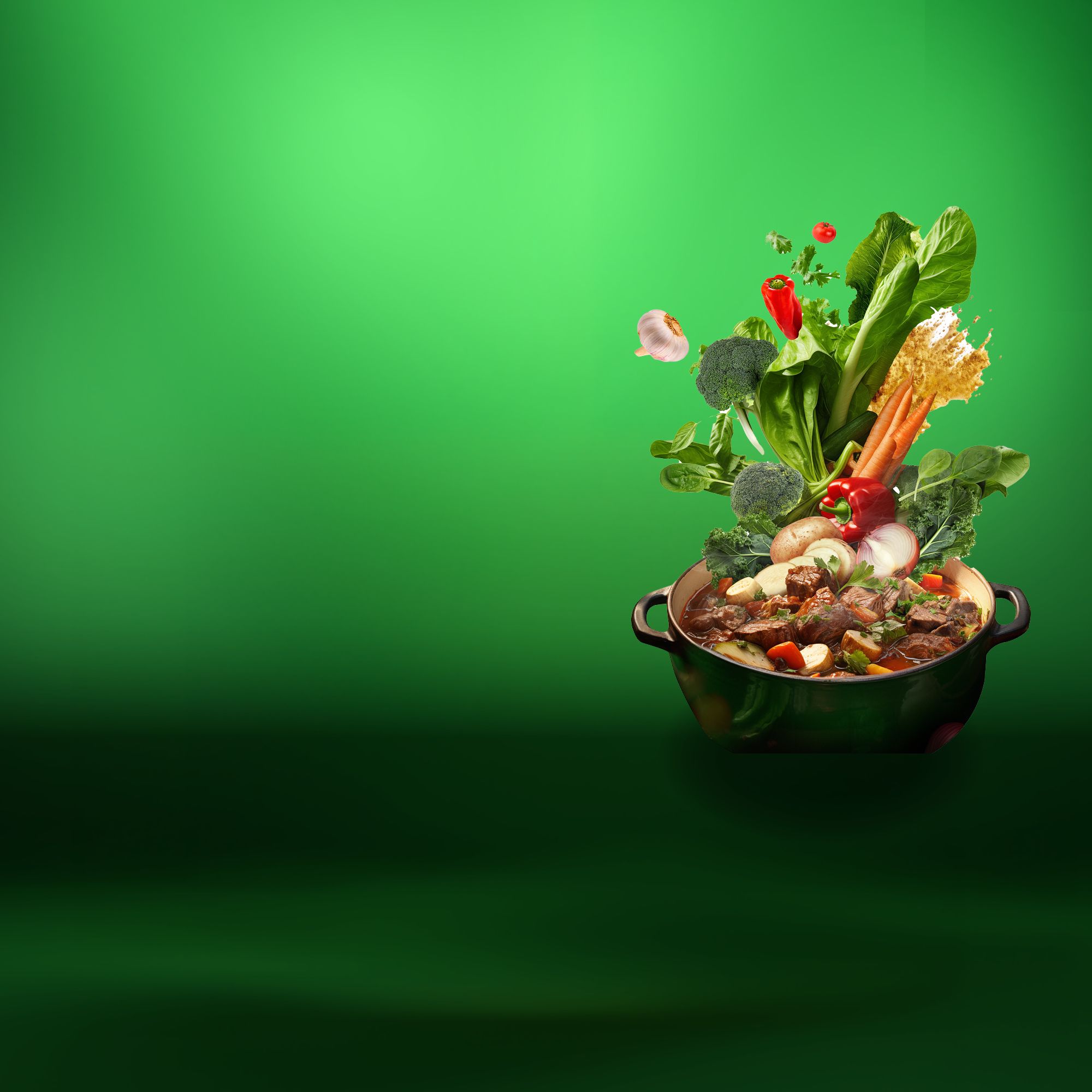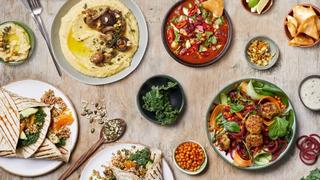
Make the good stuff irresistible
Add Some Colour To Your Plate

Take a look at your plate. Does it look like a rainbow, or is it mainly brown and beige? Read on to find out how you can add more healthy food to your diet simply by using colours as your guide!
There's no question that eating a diet packed with fruits and vegetables helps improve your overall health. However, more and more experts are saying that a healthy diet is not only about how many fruits and vegetables you eat, but also about adding variety to what you eat. According to health experts, eating a more diverse diet helps ensure that you’re continuously sampling from a range of different food groups, making it more likely that you’ll meet both your known and unknown health and immunity needs.
Why add colour?
A simple way to incorporate more fruits and vegetables to your diet is by choosing a variety of differently coloured fruits and vegetables in order to get the most vitamins and minerals from your plate.
Eating a wider variety of fruits and vegetables is not only beneficial to your health but also helps promote food security and biodiversity. Focusing our diets on varied and seasonal crops – especially locally grown foods – also helps farmers stay on their feet during difficult food production periods. So next time you fill your basket, consider adding a vibrant range of fruit and veggies to your cart.
Need some help in understanding the nutritional benefits of different coloured foods? We’re here to help.
Where Do Plants Get Their Colour From?
Plants derive their colours from the specific phytochemicals found in them. Phytochemicals are natural chemicals that help protect plants from germs, bugs, the sun’s harmful rays, and other threats. These chemicals also offer different nutrients when eaten.
The Greatness of Red
Red fruits and vegetables such as peppers, tomatoes, beetroot, strawberries, and watermelon are packed with antioxidants, Vitamin A (beta-carotene), Vitamin C, and fibre for general health support. Red fruits and vegetables also contain manganese for healthy heart health.
Red Fruit & vegetables:
Beetroot
Cherries
Cranberries & raspberries
Kidney beans
Pink grapefruit
Pomegranates
Radishes
Red cabbage
Red Peppers
Red grapes
Strawberries
Tomatoes
Watermelon
Add the greatness of red with these Knorr recipes:
Turmeric Millet Pilaf With Pickled Beetroot, Mint And Feta
Spaghetti Bolognaise With Red Kidney Beans And Baby Spinach
Spicy Boerewors and Samp Hot Pot
Cheesy Tomato Nachos
The Yay of Yellow and Orange
Orange and yellow fruits and vegetables tend to be rich in Vitamin C and carotenoids, including beta-carotene, which is known to enhance your vision, skin, joint and bone health, and immune system. Orange and yellow fruits and vegetables also tend to contain potassium, magnesium, fibre and Vitamin B6 for general health support.
Yellow & Orange Fruit & Vegetables:
Apricots
Butternut
Carrots
Lemons
Mangos
Nectarines
Pawpaws
Peaches
Pineapples
Sweetcorn
Sweet potatoes
Turmeric
Yellow peppers
Add the yay of yellow and orange with these Knorr recipes:
Turmeric, Lentil and Spinach Soup
One Pot Lemon Chicken Dinner
One Pan Pumpkin Leaf Sishebo
BBQ Salmon with Orange and Quinoa Salad
The Goodness Of Green
Green leafy vegetables such as lettuce, spinach, Swiss chard and mustard greens are strongly associated with a decreased risk of cardiovascular disease. Green vegetables and fruits tend to be rich in fibre, folate, potassium and vitamins A, C, E and K. As a leading green power food, spinach is considered one of the most nutrient-dense foods on earth.
Green Fruit & Vegetables:
Apples
Asparagus
Avocados
Broccoli
Brussel sprouts
Cabbage
Celery
Cucumbers
Green beans
Kale
Kiwi fruit
Lettuce
Marrows
Pears
Peas
Rocket
Spinach
Add the goodness of green with these Knorr recipes:
Creamed Spinach with Toasted Walnuts and Olives
Lentil Bolognaise with Zucchini Noodles
Spicy Broccoli And Mung Bean Curry
Wild Rice Chicken Salad with Baby Marrows & Avocado
The Power of Purple
Blue and purple fruits and vegetables help support healthy blood pressure and provide protection against pain and inflammation. The deep purple and blue colour of fruits and veggies is usually a sign that these foods contain a good dose of antioxidants. A particular group of antioxidants called anthocyanins gives plants (including flowers) their vivid violet colours. Anthocyanins also help protect cell health, and protect you from diseases such as cancer, diabetes, and cardiovascular and neurological decline.
Purple Fruit & Vegetables:
Blackcurrants
Blueberries
Brinjals
Currants and raisins
Figs
Granadillas
Kidney beans
Plums
Prunes
Purple grapes
Red cabbage
Add the power of purple with these Knorr recipes:
Chakalaka roasted red cabbage steaks with mixed seed
Red-Cabbage Steaks with Creamy Cheese Sauce
Brinjal and Potato Sishebo
The Nourishment Of Neutrals
White and neutral foods increase the body’s ability to fight infections and have strong antimicrobial, antiviral and antifungal properties. Neutral coloured fruits and vegetables are also high in potassium, fibre, beta-glucans, lignans, and epigallocatechin gallate (EGCG), all nutrients known for heart health, cancer prevention, immunity support, digestive tract health, and metabolism.
Neutral Fruit & Vegetables:
Bean sprouts
Butter beans
Cauliflower
Chickpeas
Mushrooms
Onions
Parsnips
Potatoes
Add the nourishment of neutrals with these Knorr recipes:
Cauliflower Millet Nuggets with Sweet 'n Sour Sauce
Mushroom and Pumpkin Leaf Ramen
Spicy Lentils with Cauliflower Florets
Sweet Potato and Spinach Stew
Tips To Help You Add More Colour To Your Plate!
- Add fruit and vegetables to foods you love. Try adding frozen peas and carrots to your stews, veggies on top of pizza and slices of fruit on top of breakfast cereals or low-fat yoghurt.
- Challenge yourself to try fruits and vegetables of different colours. Make it a red/green/orange day (apple, lettuce, carrot), or see if you can consume a rainbow of fruits and vegetables during the week.
- When shopping for fresh produce, add fruits and veggies that make up all the colours of the rainbow.
- The availability of fresh produce changes with the seasons. Each season offers its own array of fresh produce perfectly suited to your body's needs. To get the most flavour from your fruits and vegetables, shop for seasonal fruits and vegetables.
When fruits and vegetables aren’t in season, consider buying them canned or frozen for more affordable options
Looking for colour-filled dinner inspiration and Knorr recipes? Sign up to our Knorr newsletter now and get a free complimentary Future 50 recipe book!
Next article

Healthy Eating – Makeovers For Kids

whatsfordinner Menu Planner
Simply answer a few dietary questions and we will serve you a personalised weekly menu featuring recipes that suit your needs.



